Lanoxin dosages: 0.25 mg
Lanoxin packs: 60 pills, 90 pills, 120 pills, 180 pills, 270 pills, 360 pills

Purchase lanoxin with visa
Hematopoiesis in the liver and marrow of human fetuses at 5 to 16 weeks postconception: quantitative assessment of macrophage and neutrophil populations. A randomized, double-masked, placebo-controlled trial of recombinant granulocyte colony-stimulating issue administration to preterm infants with the medical analysis of earlyonset sepsis. The in vivo impact of recombinant human granulocyte-colony stimulating think about neutropenic neonates with sepsis. Neutrophil pool sizes and granulocyte colonystimulating factor manufacturing in human mid-trimester fetuses. Assessment of the contribution of the spleen to granulocytopoiesis and erythropoiesis of the mid-gestation human fetus. Recent advances in the pathogenesis and treatment of nonimmune neutropenias in the neonate. Expected ranges for blood neutrophil concentrations of neonates: the Manroe and Mouzinho charts revisited. Decreased adherence, chemotaxis and phagocytic actions of neutrophils from preterm neonates. Different maturation of neutrophil chemotaxis in time period and preterm new child infants. Neutrophil chemotaxis and random migration in preterm and term infants with sepsis. The results and comparative variations of neutrophil particular chemokines on neutrophil chemotaxis of the neonate. Mechanisms underlying reduced responsiveness of neonatal neutrophils to distinct chemoattractants. Intrapartum magnesium sulfate exposure attenuates neutrophil perform in preterm neonates. In vitro impact of indomethacin on polymorphonuclear leukocyte perform in preterm infants. Myeloid hematopoietic progress components and their role in prevention and/or therapy of neonatal sepsis. Effect of an intravenous gammaglobulin preparation on the opsonophagocytic activity of preterm serum towards coagulase-negative staphylococci. Studies on interplay of micro organism, serum factors and polymorphonuclear leukocytes in mothers and newborns. Cell-surface expression of immunoglobulin G receptors on the polymorphonuclear leukocytes and monocytes of extremely untimely infants. Effect on neutrophil kinetics and serum opsonic capacity of intravenous administration of immune globulin to neonates with medical indicators of earlyonset sepsis. Intravenous immunoglobulin for suspected or subsequently proven an infection in neonates. Structure and regulation of the neutrophil respiratory burst oxidase: comparability with nonphagocyte oxidases. Impact of prematurity, stress and sepsis on the neutrophil respiratory burst exercise of neonates. Defective neutrophil oxidative burst in preterm newborns on publicity to coagulasenegative staphylococci. The results of recombinant human granulocyte-macrophage colony stimulating factor on the neutrophil respiratory burst in the time period and preterm toddler when studied in whole blood. Hypertonic saline enhances host response to bacterial problem by augmenting receptor-independent neutrophil intracellular superoxide formation. Oxidative metabolism of wire blood neutrophils: relationship to content material and degranulation of cytoplasmic granules. Extracellular release of bactericidal/ permeability-increasing protein in newborn infants. Direct action of human granulocyte colony-stimulating factor on mature human neutrophils: flow-cytometric analysis.
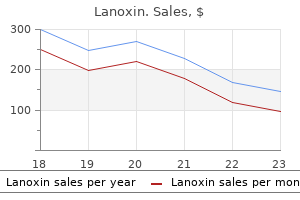
Purchase lanoxin line
Clinically, this is usually expressed as the minute quantity, or mL/kg/min, of exhaled gasoline. During high-frequency ventilation, carbon dioxide removal is the product of frequency and the square of the tidal volume. Control of air flow during patient-triggered air flow requires an understanding of the physiology of fuel exchange. Most newborns could have intact chemoreceptors and can search to preserve normocapnia. Thus, if the clinician sets the amplitude too low, the infant will compensate by growing the spontaneous (and therefore, triggered) respiratory price. Of these two parameters, adjustment in tidal volume (by adjusting the amplitude) has a extra predictable impact on minute ventilation. The pulmonary time constant refers to the time required to allow strain and volume equilibration of the lung. Early on, when compliance is poor, the baby will breathe rapidly and take shallow breaths. As the illness process remits, compliance improves, and the baby breathes extra slowly and takes deeper breaths. Ventilatory modalities can goal both pressure or quantity as the first variable. Because volume is the integral of flow, volume- and flowcontrolled ventilation are literally the same. When strain is managed, volume will fluctuate in accordance with the compliance of the lungs, and conversely, when quantity is controlled, strain will fluctuate as a function of compliance. The first of those is the variable that initiates or triggers inspiration (trigger). The third is the variable that modifications inspiration to expiration and vice versa (cycle). The clinician programmed both a set inspiratory time or ventilator price and inspiratory: expiratory ratio, and the exhalation valve would open and shut according to the lapse of time. More just lately, different triggering variables have been introduced, permitting for the synchronization of the onset of mechanical breaths to spontaneous respiratory. The clinician can set a threshold flow or strain, above which the ventilator initiates a mechanical breath. These variables are used as a surrogate for spontaneous effort and embrace pressure or circulate, with time as a backup. Most present ventilators use flowtriggering units as a result of this requires less effort to trigger and is thus related to less work of respiration. Traditionally, stress has been used as a limit variable, however quantity and flow are other variables that may restrict inspiratory move. Most neonatal ventilators, including highfrequency ventilators, are time cycled, however adjustments in airway move can also be used to end the inspiratory Classification of Mechanical Ventilators Over the previous decade, newer mechanical ventilation gadgets have been launched into neonatal apply, and devices which are primarily based on sound physiological rules. The proliferation of gadgets and methods has triggered confusion about nomenclature and classification, that are incessantly system particular. In a basic sense, mechanical ventilators can be divided into two teams: those that deliver physiologic tidal volumes, usually referred to as conventional mechanical ventilators, and those that deliver tidal volumes that are less than physiologic dead area, referred to as high-frequency gadgets, which might be discussed beneath. These variables fall into two categories, those who control the type of air flow (called ventilatory modalities) and those who decide the breath type (called ventilatory modes). Flow cycling extra precisely mimics the physiologic respiration pattern and permits for the mechanical breath to be fully synchronized to the spontaneous breath during both inspiration and expiration. Changes in transthoracic electrical impedance that occur during spontaneous respiration can be used to generate a trigger sign. A current addition to neonatal air flow has been Neurally Adjusted Ventilatory Assist. This modality makes use of the electrical activity of the diaphragm to trigger, cycle, and management the extent of help. Efforts to reduce asynchrony embrace growing the rate to override the spontaneous drive and "capture" the infant, generous use of sedatives, and in some instances, the administration of skeletal muscle relaxants.
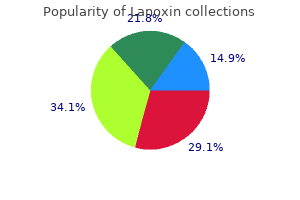
Cheap lanoxin 0.25 mg amex
Many of those findings mirror abnormalities in the embryologic growth of the ear. The exterior ear, middle ear, and eustachian tube develop from the branchial equipment starting on the fourth week of gestation. The pinna arises from the coalescence of the primary and second arch tissues of the primary branchial cleft, which will become the external auditory canal. The eustachian tube and center ear space develop from the primary pharyngeal pouch, and the ossicles from the mesoderm of the primary and second arches. The inside ear develops from surface ectoderm and neuroectoderm beginning in the third week of gestation, with the cochlea, semicircular canals, utricle, and saccule fashioned by 15 weeks. Risk issue 6 contains visible physical findings similar to white forelock, which is associated with Waardenburg syndrome. Risk issue 7 includes syndromes associated with hearing loss or progressive or late-onset hearing loss similar to neurofibromatosis, osteopetrosis, and Usher syndrome. Affected individuals develop vestibular problems secondary to progressive retinitis pigmentosa and turn out to be blind with growing age. Subtypes are associated with either mild to extreme or severe to profound listening to loss. Other regularly recognized syndromes embrace Waardenburg, Pendred, Jervell and Lange-Nielsen, and Alport syndromes. Children have sensorineural or permanent conductive listening to loss and associated heterochromia iridis. Pendred syndrome is the second most common autosomal recessive explanation for syndromic listening to loss. It is characterised by severe to profound listening to loss and euthyroid goiter, which presents throughout adolescence or later. An abnormality known as Mondini dysplasia or dilated vestibular aqueduct, which is identified by computed tomography examination of the temporal bones, is related to Pendred syndrome. Branchio-otorenal syndrome is autosomal dominant and happens in 2% of hearing loss. It is characterized by preauricular pits, malformed pinnae, branchial fistulas, and renal anomalies. Alport syndrome is X-linked or autosomal recessive, occurs in 1% of children with listening to loss, and is associated with progressive listening to loss. Risk issue eight consists of neurodegenerative disorders corresponding to Hunter syndrome or sensory motor neuropathies similar to Friedreich ataxia and Charcot-Marie-Tooth syndrome. Meningitis is associated with an increased incidence of sensorineural listening to loss. Serious head trauma, especially basal skull or temporal bone fractures requiring hospitalization, is a threat issue for listening to loss in childhood. Although all kids with a threat issue ought to have a minimal of one follow-up visit with an audiologist, kids with increased threat for delayed-onset hearing loss could require more frequent assessments. During the postdiagnosis appointment with the household, the physician critiques the being pregnant, neonatal, and household historical past for hearing loss, re-examines the kid for evidence of any craniofacial abnormalities or a syndrome related to hearing loss, and discusses the benefits of early intervention services and amplification. The main care physician therefore needs to pay attention to community sources and to help the household choice of early intervention program and mode of communication. Every infant with confirmed listening to loss ought to be evaluated by an otolaryngologist with information of pediatric listening to loss. The otolaryngologist conducts a comprehensive assessment to decide the etiology of hearing loss and offers recommendations and data to the family, audiologist, and primary care provider on candidacy for amplification, assistive devices, and surgical intervention, together with reconstruction, bone-anchored listening to aids, and cochlear implantation. Because of the prevalence of hereditary hearing loss, all households of kids with confirmed hearing loss should be provided a genetics evaluation and counseling. This evaluation can present households with information on etiology, prognosis, associated disorders, and the chance of listening to loss in future offspring. Because 30% to 40% of children with confirmed listening to loss have comorbidities or different disabilities, the first care physician ought to carefully monitor developmental milestones and provoke referrals associated to suspected disabilities as wanted. Evidence suggests that no profit is derived from using antihistamines or decongestants in kids. Tympanostomy has been proven to be related to decreases in center ear effusion and improved listening to. Communication Options One of the necessary choices that the household must make for the kid is the communication mode that may work optimally for the kid and family. Auditory oral communication encourages the utilization of residual listening to and amplification with visual support (speech reading), and the aim is spoken language.
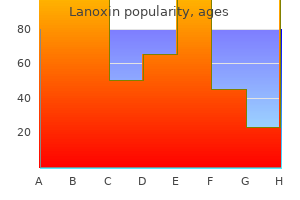
Buy cheap lanoxin 0.25 mg on-line
Prevalence of spontaneous closure of the ductus arteriosus in neonates at a start weight of a thousand grams or less. Effect of furosemide on ductal closure and renal operate in indomethacin-treated preterm infants during the early neonatal interval. Expression, exercise, and function of phosphodiesterases within the mature and immature ductus arteriosus. Towards rational administration of the patent ductus arteriosus: the necessity for illness staging. Outcome of children in the indomethacin intraventricular hemorrhage prevention trial. Patent ductus arteriosus and cystic periventricular leucomalacia in preterm infants. Left vocal wire paralysis after excessive preterm delivery, a brand new clinical state of affairs in adults. Long-term effects of indomethacin prophylaxis in extremely-low-birth-weight infants. Functional echocardiography in staging for ductal disease severity: position in predicting outcomes. A blinded comparability of scientific and echocardiographic analysis of the preterm toddler for patent ductus arteriosus. Postoperative cardiorespiratory instability following ligation of the preterm ductus arteriosus is related to early want for intervention. Developmental absence of the O2 sensitivity of L-type calcium channels in preterm ductus 38. Repeated programs of ibuprofen are effective in closure of a patent ductus arteriosus. Prophylactic ibuprofen in untimely infants: a multicentre, randomised, double-blind, placebo-controlled trial. Early versus late indomethacin treatment for patent ductus arteriosus in premature infants with respiratory distress syndrome. School-age outcomes of very low birth weight infants in the indomethacin intraventricular hemorrhage prevention trial. Prophylaxis of early adrenal insufficiency to prevent bronchopulmonary dysplasia: a multicenter trial. Effects of early indomethacin administration on oxygenation and surfactant requirement in low birth weight infants. The blood flow in these sufferers is in parallel with the deoxygenated blood entering the aorta and recirculating to the body while the richly oxygenated pulmonary venous return is recirculated to the lungs. In the absence of any shunting across connections between the systemic and pulmonary circulations, this ends in systemic hypoxia and is usually lethal. Fetal prognosis is frequent however not uniform; however, even with prenatal diagnosis, profound hypoxia owing to a extremely restrictive patent foramen ovale can result in speedy deterioration and death within the first hours of life. A holosystolic murmur, when present, suggests an associated ventricular septal defect; a systolic ejection murmur is auscultated when the patient has pulmonary stenosis. Persistent ductal patency or excessive pulmonary vascular resistance will have an effect on the clinical findings of an related ventricular septal defect or coarctation of the aorta. Laboratory Evaluation the electrocardiogram is regular or can present right ventricular hypertrophy after a quantity of weeks of life. Echocardiography defines the associated defects and coronary artery anatomy, which is central to surgical planning. At a minimal, an atrial septal defect with balanced bidirectional shunting is crucial for survival. Its presence also leads to mixing of the oxygen-rich and desaturated blood, but as beforehand stated, atrial level mixing is probably the most reliable. This shunting on the ductal level may enhance the pulmonary venous return, distending the left atrium and facilitating shunting from the left to the proper atrium of totally saturated blood throughout the foramen ovale. The aorta is anterior and proper of the pulmonary artery in d-transposition of the greatarteries. Often, infants with atretic or absent pulmonary arteries have a quantity of aortopulmonary collaterals as their pulmonary blood move.
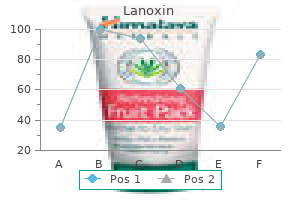
Discount 0.25mg lanoxin with visa
Additional genetic syndromes are recognized each year as technical advances in genetic screening occur. Migrational Anomalies Neuronal migration is a radial and tangential process by which nerve cells transfer from their progenitor cell origin in the ventricular zone and basal forebrain to their final vacation spot in the cerebrum. Because of this cortical disruption, seizures are the commonest clinical manifestation of migrational disorders. In polymicrogyria, the gyri are too numerous and too small, with a proliferation of secondary and tertiary sulci. Neuronal heterotopias (brain warts) are the least extreme of the migrational disorders and may stand alone or occur in association with other disturbances of migration. The triad of agenesis of the septum pellucidum, optic nerve hypoplasia, and pituitary abnormalities known as septo-optic dysplasia, or De Morsier syndrome. Congenital Infections the growing nervous system is vulnerable to quite lots of in utero infections. Biochemical Disorders Several maternal metabolic disorders similar to diabetes mellitus and uremia are related to congenital main microcephaly. Untreated phenylketonuria in an asymptomatic mom could also be related to microcephaly in a non-phenylketonuric infant. Teratogenic agents corresponding to nicotine, phenytoin, cortisone, cocaine, alcohol, isotretinoin, and carbon monoxide can produce microcephaly along with disorders of neuronal induction and migration. Maternal exposure to ionizing radiation has been implicated as a explanation for congenital microcephaly, with earlier insults associated with extra severe cases. Two subgroups of micrencephaly have been postulated: radial microbrain and micrencephaly vera. This scheme is predicated on the work of Mn and colleagues,66 who proposed a radial unit mannequin to clarify the major ontogenetic improvement of the cerebral cortex. Noncontrast computed tomography scan shows ex vacuo hydrocephalus and periventricular calcifications. Early symmetric division of stem cells creates these proliferative models, which behave as organized cylindrical columns containing neurons. Later asymmetric division of stem cells causes the proliferative items to enlarge, with elevated numbers of neurons. Subsequent migration of the proliferative models collectively as columns alongside radial glia explains the evolution of the cerebral cortex from the primitive ventricular zone. Radial microbrain and micrencephaly vera are issues of micrencephaly related to impaired neuronal proliferation, and can be categorized as forms of main microcephaly in the conventional classification scheme. Radial microbrain is a rare condition described in seven instances by Evrard and colleagues,38 in which the mind is extraordinarily small with normal gyri and regular cortical lamination. The brain can be as small as sixteen g at term (the normal newborn brain is 350 g), and within the reported circumstances, dying has occurred in the first month. Radial microbrain is considered a genetic disorder, more than likely with autosomal recessive inheritance. The pathologic finding is a marked discount within the variety of cortical neuronal columns (proliferative units), but a normal number of neurons per column. The reduced variety of columns with preservation of columnar dimension suggests that the insult happens early within the embryonic section of neuronal proliferation. Micrencephaly vera (true micrencephaly) describes a heterogeneous dysfunction in which the brain is properly fashioned with a simple gyral pattern and small, but not as small because the radial microbrain. Pathologically, the variety of cortical neuronal columns is regular, but the size of the columns is small due to a lowered variety of neurons per column. The timing of the embryologic insult is later than that for radial microbrain, most likely between the 6th and 18th weeks of gestation. The distinction between radial microbrain and micrencephaly vera is of particular curiosity to investigators finding out neuronal proliferation and the evolution of human cerebral neocortex from progenitor cells lining the embryologic ventricle. Thus, secondary microcephaly arises after neuronal induction, proliferation, and migration, sometimes from disorders within the last 2 months of the third trimester of being pregnant or in the perinatal period. Craniosynostosis causes microcephaly only not often, when there was untimely fusion of multiple sutures. In this setting, the cranium restricts development of the brain and the infant might show irritability, lethargy, and vomiting as manifestations of elevated intracranial pressure.
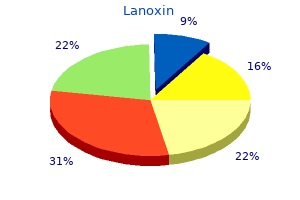
Purchase generic lanoxin pills
The emergence of feeding intolerance in addition to rising lethargy, stupor, coma, and seizures is an early indication of an inborn metabolic disturbance through the first few days of life. The new child with an inherited metabolic disorder might initially present as a neurologically depressed and hypotonic youngster with asphyxia and seizures. Some youngsters reply to particular dietary therapies, including vitamin supplementation, depending on the enzymatic defect. Specific urea cycle defects, corresponding to ornithine transcarbamylase or carbamoyl phosphate synthetase deficiency, could current with coma and seizures through the first 2 days of life, with marked elevations in plasma ammonia levels. These infants may respond to aggressive therapy with an exchange transfusion, dialysis, and acceptable dietary adjustments. Prophylactic doses of pyridoxine could also be wanted to achieve and preserve seizure control. Other rare causes of seizures embrace problems of carbohydrate metabolism with coincident hypoglycemia,fifty four in addition to peroxisomal disorders, similar to neonatal adrenoleukodystrophy or Zellweger syndrome. A defect in a glucose transporter protein essential to transfer glucose throughout the blood-brain barrier has also been reported, which leads to hypoglycorrhachia and seizures. Molybdenum cofactor deficiency and isolated sulfite oxidase deficiencies are other uncommon metabolic defects that trigger neonatal seizures and related destructive adjustments on neuroimaging, which can resemble cerebrovascular disease or asphyxial insults. Certain drugs, corresponding to short-acting barbiturates, could additionally be related to seizures throughout the first several days of life. Seizures might happen instantly after substance withdrawal, or be related to longer-standing uteroplacental insufficiency promoted by persistent substance use and poor prenatal health maintenance by the mother. Careful review of placental-cord specimens may reveal chronic or acute lesions that contribute to antepartum or intrauterine asphyxia. Inadvertent fetal injection with a local anesthetic agent throughout supply may induce intoxication, which is a uncommon cause of seizures. Patients current in the course of the first 6 to eight hours of life with apnea, bradycardia, and hypotonia, and are comatose, with out brainstem reflexes. Determination of plasma levels of the suspected anesthetic agent establishes the prognosis. Treatment consists of ventilatory support and removing the drug by therapeutic diuresis, acidification of the urine, or exchange transfusion. Rarely, neonates with idiopathic localization-related or partial seizures without neuroimaging abnormalities present with intractable epilepsy. Neurocutaneous syndromes, such as incontinentia pigmenti and tuberous sclerosis, may current during the neonatal period with symptomatic epilepsy as one clinical manifestation of these genetic disorders (see Chapter 102). Incontinentia pigmenti is accompanied by a vesicular crusting rash that originally mimics a herpetic an infection. Two common fetal shows of tuberous sclerosis are a cardiac tumor, usually a rhabdomyoma, or hardly ever a connatal mind tumor, both noted on fetal sonography. Neonatal seizures also will be the presenting feature,60 with documentation of intracranial lesions on postnatal neuroimaging. Exposure to barbiturates, alcohol, heroin, cocaine, or methadone generally presents with neurologic findings that embody tremors and irritability (see Chapter 53). Response to antiepileptic treatment is normally good, although some authors describe variable success. Further research are wanted to clarify the connection between phenotypic and genotypic expressions of this dysfunction. Seizures in neonates after asphyxia assist either acute intrapartum events or antepartum disease processes. The child with seizures can also categorical scientific and laboratory indicators of evolving cerebral edema. The presence of a bulging fontanelle with neuroimaging evidence of elevated intracranial stress and cerebral edema. Hyponatremia and elevated urine osmolality suggest the syndrome of inappropriate secretion of antidiuretic hormone accompanying acute or subacute cerebral edema. Alternatively, failure to document evolving cerebral edema in the course of the first 3 days after asphyxia, or documentation of encephalomalacia or cystic mind lesions on neuroimaging shortly after birth. Liquefaction necrosis requires 2 weeks or longer after the presumed in utero asphyxial occasion to produce a cystic cavity, which is then visible on neuroimaging. Isolated seizures in an otherwise asymptomatic neonate can counsel a illness course of occurring during either the postnatal or antepartum durations. Neonates current with seizures as a end result of postnatal diseases from intracranial infection, cardiovascular lesions, drug toxicity, or inherited metabolic ailments.
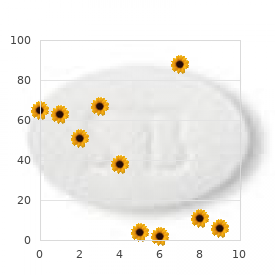
Buy generic lanoxin online
In persistent hemolytic states, compensatory hypertrophy of the bone marrow might end in bony adjustments and other evidence of extramedullary hematopoiesis. Extrinsic hemolysis may be divided into immune and nonimmune etiologies (see Box 88-1); the most common causes of immune hemolytic anemia are discussed first. Particularly for Rh (D), anti-c, anti-E, and anti-K (Kell) antibodies, intrauterine or direct fetal transfusion could also be indicated prenatally, and trade transfusion may be essential postnatally. Maternal IgG antibodies can cross the placenta, enter the fetal circulation and cause hemolysis, anemia, hyperbilirubinemia, and hydrops fetalis. Transfer of antibodies across the placenta is dependent upon the Fc part of the IgG molecule. Because each IgM and IgA antibodies lack this component, solely IgG antibodies trigger hemolytic disease of the new child. Immunoglobulin G1 antibodies cross the placenta earlier and are liable for more prenatal hemolysis. Immunoglobulin G3 antibodies cross the placenta later in gestation and are responsible for extra extreme hemolysis postnatally. With the widespread use of antenatal and postpartum Rh immunoglobulin administration, Rh D sensitization is much less common in pregnancies when prenatal care is acquired. The incidence of Rh disease is dependent upon the prevalence of Rh-negative antigens within the inhabitants studied (Table 88-9). Partial or complete change transfusions may be essential to scale back the load of antibody and take away the antibody-coated cells. Infants might develop anemia, reticulocytosis, and hyperbilirubinemia throughout the first 24 hours of life. Maternal antibodies towards minor blood group antigens develop after exposure from a transfusion or prior pregnancy, or from contact with bacteria or viruses that express the antigen. The prognosis and therapy of hemolytic illness are similar to those for Rh hemolytic illness. Hydrops fetalis is essentially the most extreme consequence of hemolysis, however anemia usually is less problematic than hyperbilirubinemia in the acute part of illness. Anemia can occur within the first few weeks in both those that received change transfusions and individuals who required solely phototherapy for administration of hyperbilirubinemia. The anemia may be attributable to ongoing hemolysis, hypersplenism, insufficient alternative by transfused red blood cells, and shortened survival of transfused purple blood cells. Because the half-life of IgG molecules is about 28 days, hemolysis should resolve inside the first three or four months. Autoimmune hemolytic anemia happens, as do anemias related to infections, medicine, and immunodeficiency syndromes. IgG antibodies, with or without complement, are often directed towards one of the Rh erythrocyte antigens. These antibodies are most lively at 37�C and sometimes are referred to as heat autoantibodies. The IgG-coated cells, with or with out the assist of complement, are cleared by the spleen and, to a lesser extent, by the liver. The best-known causes of cold hemagglutinin illness are Mycoplasma pneumoniae, adenovirus, and Epstein-Barr virus. Immunoglobulin A-mediated hemolysis is kind of uncommon but is remarkable for its severity (Table 88-10). The pure historical past of autoimmune hemolytic illness in infancy is that of a fast onset of anemia with hyperbilirubinemia, splenomegaly or hepatomegaly, and hemoglobinuria (with intravascular hemolysis). A subset of patients youthful than 2 years, and with a slower onset of disease at presentation, develops persistent hemolytic anemia. Difficulties with identifying compatible blood throughout a hemolytic disaster, as well as the normally self-limited nature of the disease, restrict blood transfusions to instances during which extreme anemia impairs tissue oxygenation. The lipid bilayer that types the cell membrane is the site of numerous biologic features mediated by integral proteins.
Order lanoxin once a day
The benign and severe varieties are differentiated by immunohistochemical techniques, utilizing antibodies directed towards completely different subunits of cytochrome-c oxidase. Muscle biopsy reveals irregular glycogen storage, and analysis is established by demonstration of the debrancher enzyme deficiency. However, the dysfunction exhibits clinical variability and infrequently presents through the neonatal period. In some infants, the weakness is excessive, contractures are present, and the result fatal. Muscle biopsy exhibits variations in fiber dimension, absence of phosphorylase staining, and subsarcolemmal glycogen-containing vacuoles. There has been some success with high-protein diets or ingestion of sucrose before exercise. Enzyme replacement therapy within the infantile form of Pompe illness: Argentinean expertise in a seven-year follow up case. Neurological growth from birth to six years: information for examination and analysis. Fatal familial childish glycogen storage illness: multisystem phosphofructokinase deficiency. Assignment of a type of congenital muscular dystrophy with secondary merosin deficiency to chromosome 1q42. Survival motor neuron gene deletion within the arthrogryposis multiplex congenita-spinal muscular atrophy affiliation. Clinical and genetic distinction between WalkerWarburg syndrome and muscle-eye-brain illness. Arthrogryposis multiplex in a new child of a myasthenic motherase report and literature. Diagnosis is established by demonstrating a reduction of phosphofructokinase exercise biochemically and histochemically. Rarely, it presents through the neonatal interval with weakness, hypotonia, and cardiomyopathy. Congenital myasthenic syndrome due to rapsyn deficiency: three cases with arthrogryposis and bulbar symptoms. The congenital and limb-girdle muscular dystrophies: sharpening the primary focus, blurring the boundaries. A gene for a extreme lethal form of X-linked arthrogryposis (X-linked infantile spinal muscular atrophy) maps to human chromosome Xp11. Identification of a new locus for a peculiar form of congenital muscular dystrophy with early rigidity of the backbone, on chromosome 1p35-36. The results of maternal magnesium sulfate therapy on newborns: a prospective managed examine. Different patterns of obstetric issues in myotonic dystrophy in relation to the illness standing of the fetus. Disturbance of muscle fiber differentiation in congenital hypomyelinating neuropathy brought on by a novel myelin protein zero mutation. Immunolocalization of a number of laminin chains within the normal human central and peripheral nervous system. Genetics of congenital central hypoventilation syndrome: lessons from a seemingly orphan illness. Paternal transmission of the congenital form of myotonic dystrophy type 1: a model new case and evaluate of the literature. Emphasis is on the clinical presentation, diagnostic procedures, and out there treatment choices. For preterm infants, gestation-adjusted age ought to be recorded on development charts until 24 to 36 months. Examination of the Head Physical examination is the first methodology to identify abnormalities of head measurement and form. The scalp is examined for the presence of a neurocutaneous signature similar to a dimple, dermal sinus, hemangioma, or port wine stain. Certain mass lesions are easily detected, such as tumors of the scalp and calvaria, traumatic subperiosteal hemorrhage (cephalohematoma), and cranial dysraphic lots, corresponding to an encephalocele. The form of the pinnacle is noted and the patency of the cranial sutures is ascertained. The anterior fontanelle is a diamond-shaped gentle spot on the junction of the frontal and parietal bones that marks the positioning of the lengthy run bregma, a craniometric point that denotes the junction of the metopic, coronal, and sagittal sutures.
References
- Prince CL, Scardino PL, Wolan CT: The effect of temperature, humidity and dehydration on the formation of renal calculi, J Urol 75:209n215, 1956.
- Bolan CD, Carter CS, Wesley RA, et al. Prospective evaluation of cell kinetics, yields and donor experiences during a single large-volume apheresis versus two smaller volume consecutive day collections of allogeneic peripheral blood stem cells. Br J Haematol. 2003;120:801-807.
- Mori E, del Zoppo GJ, Chambers JD, et al. Inhibition of polymorphonuclear leukocyte adherence suppresses no-reflow after focal cerebral ischemia in baboons. Stroke 1992;23:712-18.
- Nicolaides KH, Campbell S, Gabbe SG, Guidetti R. Ultrasound screening for spina bifida: cranial and cerebellar signs. Lancet 1986; ii: 72-4.






